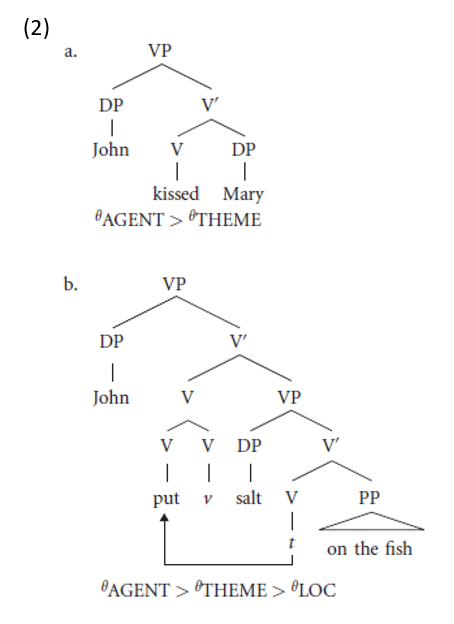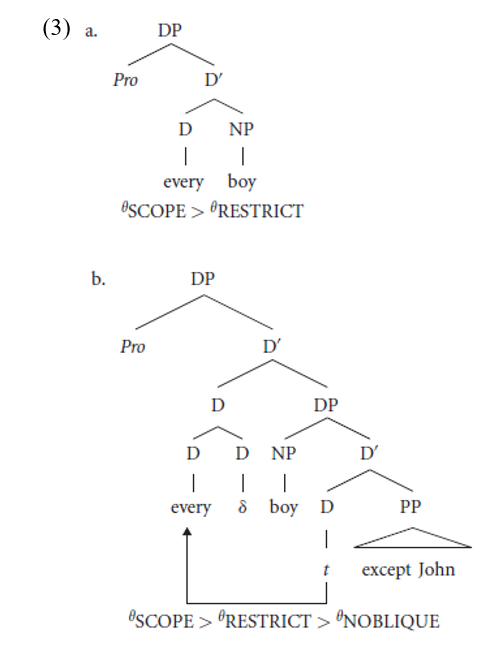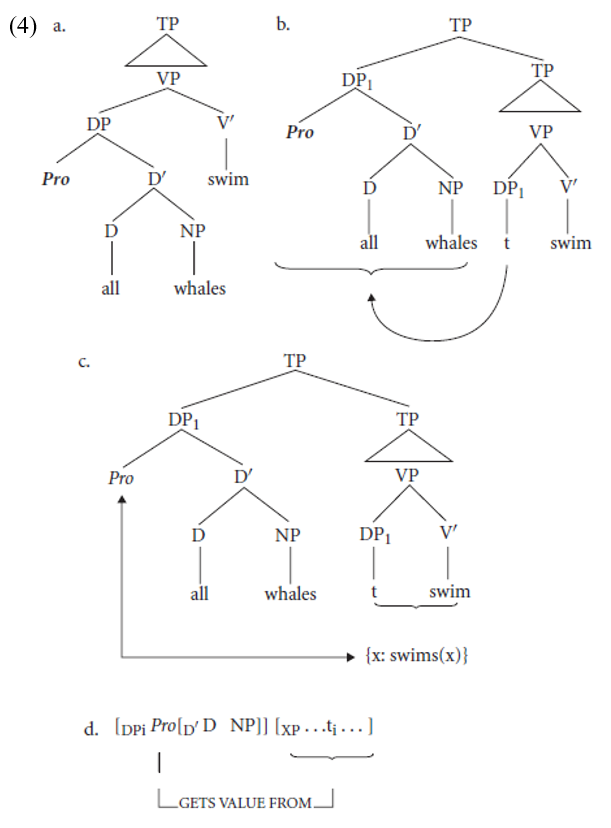


 Grammar
Grammar
 Tenses
Tenses
 Present
Present
 Past
Past
 Future
Future
 Parts Of Speech
Parts Of Speech
 Nouns
Nouns
 Verbs
Verbs
 Adverbs
Adverbs
 Adjectives
Adjectives
 Pronouns
Pronouns
 Pre Position
Pre Position
 Preposition by function
Preposition by function 
 Preposition by construction
Preposition by construction
 Conjunctions
Conjunctions
 Interjections
Interjections
 Grammar Rules
Grammar Rules
 Linguistics
Linguistics
 Semantics
Semantics
 Pragmatics
Pragmatics
 Reading Comprehension
Reading Comprehension|
Read More
Date: 2024-01-24
Date: 2024-01-23
Date: 26-2-2022
|
A thematic analysis of DP
In DP quantification, the set Y is normally given by the internal argument of D: the nominal that D combines with, usually referred to as “the restriction on quantification.” The set X is given by the external argument of D: the expression that DP is adjoined to, usually called “the scope of quantification.” Larson (2000c) suggests that notions like scope and restriction be understood as thematic roles assigned by determiners to their set arguments, and ordered into a hierachy as shown in (1a). On this proposal, there is a hierarchy of Ë-roles for D, parallel to, but distinct from, the hierarchy of Ë-roles for V (1b).

The parallel thematic analysis of D and V allows for a parallel account of structure. In the shell theory of Larson (1988, forthcoming), transitive VPs receive a simple binary branching structure (2a), whereas ditransitive Vs receive a structure containing a phonetically null “light verb” that triggers V-raising (2b).

In both cases, arguments appearing higher in structure (as expressed by c-command) receive Ë-roles that are correspondingly higher on the thematic hierarchy.
In a similar way, DPs can be assigned a structure that reflects the thematic hierarchy for D. Simple quantificational DPs correspond to transitive structures and receive the binary branching structure in (3a). “Ditransitive” (that is, triadic) determiners like every . . . except or more . . . than receive a structure containing a phonetically null “light determiner” that triggers D-raising (3b).

Here Pro is a pro-predicate argument corresponding to the scope, whose content is given by the phrase that DP is sister to at LF (4a–d).

The same analysis applies straightforwardly to examples with a quantified DP object. Again, note that in (3a, b) (set) arguments appearing higher in structure (as expressed by c-command) receive Ë-roles correspondingly higher on the thematic hierarchy.
|
|
|
|
دخلت غرفة فنسيت ماذا تريد من داخلها.. خبير يفسر الحالة
|
|
|
|
|
|
|
ثورة طبية.. ابتكار أصغر جهاز لتنظيم ضربات القلب في العالم
|
|
|
|
|
|
|
سماحة السيد الصافي يؤكد ضرورة تعريف المجتمعات بأهمية مبادئ أهل البيت (عليهم السلام) في إيجاد حلول للمشاكل الاجتماعية
|
|
|